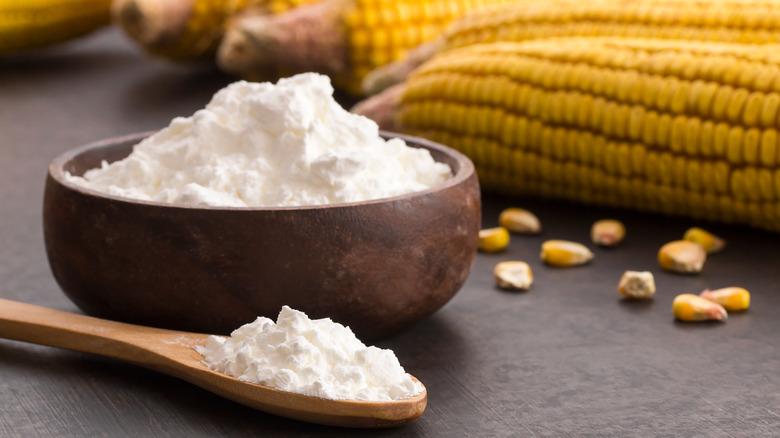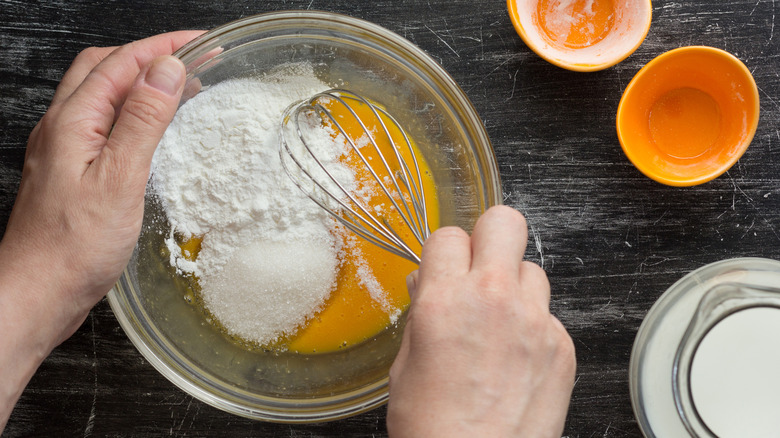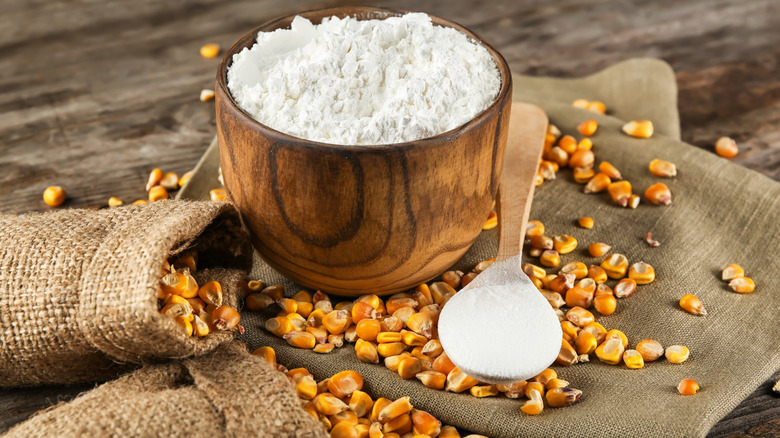Is Cornstarch Really As Bad As You Think?
Cornstarch is a common thickening agent used in a multitude of recipes, from soups and sauces to desserts, notes The Spruce Eats. Manufacturers across various industries add this white, odorless powder to pills and capsules, paper, textiles, plastics, and other goods. The starch can also substitute flour thickeners in gluten-free recipes. What's more, it can be used as an anti-caking agent due to its ability to prevent granulated or powdered food ingredients from sticking together and forming clumps.
This common food additive has a relatively high calorie count, but little nutritional value. An ounce of cornstarch provides 108 calories, nearly 26 grams of carbs, and less than 1 gram of protein and fats (via FatSecret). Due to its high carb content, it can increase the glycemic index (GI) of food, causing insulin spikes. The GI measures the impact of carbohydrate-containing foods on blood sugar, explains Harvard Medical School.
That said, should you use cornstarch in your favorite recipes or seek healthier alternatives? Let's find out.
Think twice before cooking with cornstarch
Rich in fiber and essential minerals, corn can be a healthy addition to most diets. Unfortunately, we can't say the same about cornstarch. This popular food ingredient is high in carbs and contains negligible amounts of vitamins, minerals, fiber, and other key nutrients (via FatSecret). According to the Glycemic Index Guide, it has a glycemic index (GI) value of 85, meaning that it can raise your blood sugar just as much as white bread, or breakfast cereals.
High GI foods cause blood glucose spikes followed by crashes, which lead to insulin resistance, diabetes, and obesity in the long run, warns the Cleveland Clinic. On top of that, it may alter blood lipids and affect cardiovascular health. Another aspect to consider is that cornstarch has little or no fiber, which is a nutrient that slows sugar absorption into your system, notes the Mayo Clinic.
Those trying to lose weight, lower their cholesterol, or maintain a specific low-calorie or low-carb diet may want to skip the cornstarch. Foods with high GI values, especially those containing refined carbs, could put you at risk for heart disease, metabolic disorders, and premature death, according to a 2020 study published in PLoS One. While it's true that most recipes call for small amounts of cornstarch, you may still experience a sudden increase in blood sugar levels. These fluctuations in blood glucose have both immediate and long-term effects, including low energy, difficulty thinking, and vision problems, explains Everyday Health.
Does cornstarch have any health benefits?
Cornstarch may not be the healthiest choice for your recipes, but it has its share of benefits. For starters, it's gluten-free, says Beyond Celiac. Therefore, it's suitable for people who are allergic or intolerant to gluten, including those with Celiac disease (via Beyond Celiac). Even so, you should still check the label to make sure the starch hasn't been manufactured in a facility that processes wheat and other sources of gluten, as there is a risk of cross-contamination.
This food additive may also benefit athletes, according to a clinical trial published in the journal, Nutrition. As the researchers note, consuming modified starch before exercise can prevent glycogen depletion and increase fat breakdown to a higher extent than maltodextrin, a nonsweet polymer rich in simple carbs (via Science Direct). After ingestion, carbohydrates are converted to glucose and used for energy. Some are stored as glycogen in the liver and muscles, explains a 2018 study. Glycogen levels decrease during exercise, leading to fatigue. Cornstarch and other high-carb foods can boost your glycogen levels, allowing you to work out harder for longer.
Apart from that, cornstarch can be applied topically for skin irritation, blisters, or bug bites, suggests Healthline. For example, you could rub cornstarch between your thighs to reduce or prevent chafing. Alternatively, mix it with coconut oil and baking soda to make a natural deodorant. Cornstarch and baking soda absorb moisture, while coconut oil hydrates your skin and kills bacteria, as per SCL Health.
Why you should never eat raw cornstarch
Generally, it's not a good idea to eat raw cornstarch, especially if you have a sensitive stomach. Raw starches are hard to digest and may cause bloating, says Livestrong. If you find yourself craving raw cornstarch, it could be a sign of pica, an eating disorder characterized by strong cravings for non-edible items, explains a 2012 study featured in PLoS One.
The consumption of clay, raw starches, and other non-food substances can affect nutrient absorption and cause toxicity or infection. This health condition may be due to low levels of zinc, iron, and other minerals, but it can also worsen existing nutrient deficiencies, according to a 2015 meta-analysis published in the American Journal of Human Biology.
Raw cornstarch can also be contaminated with bacteria, warns Livestrong. Additionally, raw corn products may contain aflatoxin and other naturally occurring toxins linked to cancer and immune disorders, notes the World Health Organization. Eating small amounts of raw cornstarch is unlikely to cause food poisoning, but there's still a risk.
Alternatives to using cornstarch
So is cornstarch really as bad as you think? It depends. If you are trying to maintain a specific diet or have underlying health issues, it may be best to choose another ingredient as a thickener in your recipes. It is also important to note that cornstarch is consumed in small doses — typically around 1 to 2 tablespoons — meaning that cornstarch can generally be enjoyed in moderation with a well-rounded diet (via Healthline).
But if you would prefer to replace cornstarch in your recipes, there are some substitutes that contain more nutritional benefits. Flours like oak, tapioca, or wheat flour, and xanthan gum are a few popular alternatives (via Medical News Today).
You can also cook foods for longer to promote natural thickening, or add in ingredients like coconut milk, cow's milk, or yogurt.





